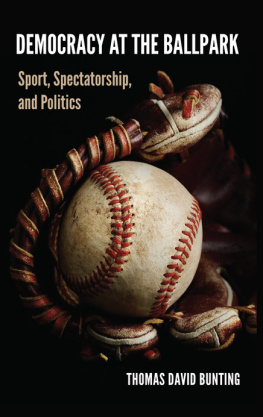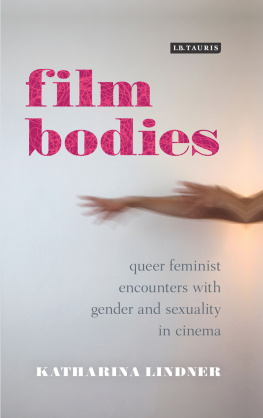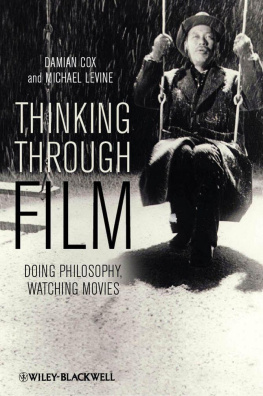CINESEXUALITY
Queer Interventions
Series editors:
Noreen Giffney and Michael ORourke
University College Dublin, Ireland
Queer Interventions is an exciting, fresh and unique new series designed to publish innovative, experimental and theoretically engaged work in the burgeoning field of queer studies.
The aim of the series is to interrogate, develop and challenge queer theory, publishing queer work which intersects with other theoretical schools and is accessible whilst valuing difficulty; empirical work which is metatheoretical in focus; ethical and political projects and most importantly work which is self-reflexive about methodological and geographical location.
The series is interdisciplinary in focus and publishes monographs and collections of essays by new and established scholars. The editors intend the series to promote and maintain high scholarly standards of research and to be attentive to queer theorys shortcomings, silences, hegemonies and exclusions. They aim to encourage independence, creativity and experimentation: to make a queer theory that matters and to recreate it as something important; a space where new and exciting things can happen.
Forthcoming titles
Gay Men and Form(s) of Contemporary US Culture
Richard Cante
ISBN: 978-0-7546-7230-2
Lesbian Dames: Sapphism in Eighteenth-Century England
John Benyon and Caroline Gonda
ISBN: 978-0-7546-7335-4
The Ashgate Research Companion to Queer Theory
Noreen Giffney and Michael ORourke
ISBN: 978-0-7546-7135-0
Critical Intersex
Morgan Holmes
ISBN: 978-0-7546-7311-8
Jewish/Christian/Queer
Frederick Roden
ISBN: 978-0-7546-7375-0
Cinesexuality
PATRICIA M AC CORMACK
First published 2008 by Ashgate Publishing
Published 2016 by Routledge
2 Park Square, Milton Park, Abingdon, Oxon OX14 4RN
711 Third Avenue, New York, NY 10017, USA
Routledge is an imprint of the Taylor & Francis Group, an informa business
Copyright 2008 Patricia MacCormack.
Patricia MacCormack has asserted her moral right under the Copyright, Designs and Patents Act, 1988, to be identified as the author of this work.
All rights reserved. No part of this book may be reprinted or reproduced or utilised in any form or by any electronic, mechanical, or other means, now known or hereafter invented, including photocopying and recording, or in any information storage or retrieval system, without permission in writing from the publishers.
Notice:
Product or corporate names may be trademarks or registered trademarks, and are used only for identification and explanation without intent to infringe.
British Library Cataloguing in Publication Data
MacCormack, Patricia
Cinesexuality. - (Queer interventions)
1. Sex in motion pictures 2. Gaze in motion pictures
3. Homosexuality and motion pictures
I. Title
791.43019
Library of Congress Cataloging-in-Publication Data
MacCormack, Patricia.
Cinesexuality / by Patricia MacCormack.
p. cm. -- (Queer interventions)
Includes index.
ISBN 978-0-7546-7175-6 (alk. paper)
1. Homosexuality and motion pictures. 2. Sex in motion pictures. 3. Gaze in motion pictures.
I. Title.
PN1995.9.S45M24 2008
302.2343--dc22
2008008234
ISBN-13: 978-0-754-67175-6 (hbk)
Contents
For Antonio Moleta
Series Editors Preface
For the Love of Cinema
What does it mean to want cinema as a lover? This desire is within us all according to Patricia MacCormack: It knows no gender, no sexuality, no form and no function. How more precisely might we understand cinema, not as an object, but a territory of desire; a space where transformations take place through the encounters that unfold there? Cinesexuality, the neologism of this books title, facilitates MacCormacks lavish meditation on the messy entanglements of spectatorship, in which she draws on the ideas of a wide range of thinkers including Gilles Deleuze, Flix Guattari, Baruch Spinoza, Rosi Braidotti, David N. Rodowick, Jean-Franois Lyotard, Jacques Rancire, Elizabeth Grosz, Maurice Blanchot, Paul Virilio, Georges Bataille, Michel Serres, Gottfried Wilhelm Leibniz, Luce Irigaray, Jacques Derrida, Giorgio Agamben and Michel Foucault. Cinesexuality is a philosophical text for cinema is itself a philosophy and the true philosopher of cinema is the spectator. MacCormack does not write so much about images (making them central) but probes around and through them (decentring and disorganising them). Her book is, as she says, cinematically filmy rather than about films. MacCormack chooses, for her purposes, not the award-laden pickings of the so-called avant-garde but the extreme pleasures of low-budget horror films. This openness to the Other is significant when we think of this books refusal to be constrained by the proscriptions of boundaries or the prescriptions of proper objects; its authors commitment to pushing the limits of what has been deemed possible or acceptable. MacCormack has produced a treatise on cinesexual desire which in her words, is not for anything, it is found in the coming to and openness toward images. It is defined in other words, not by what we take, but by what we are willing to give.
This openness before cinema, an unresponsive element, is one of supplication, a gifting of the self before the image which is not based on the sense of sight alone. It is the cinesexual event of spectatorship. As MacCormack reminds us, cinesexuality is present in acts of seeing with our viscera as our eye squints in delicious aversion. It is the giving of our/selves in ways we cannot know in advance. The cinesexual relation is an embodied one; a desire for neither specific films nor images, but for the experience of such a relation and the affects it produces. It is expressed, as the quotation above illuminates, in desires we do not even know we have: The body is a thousand plateaus, as is the event of cinesexuality. When MacCormack writes that cinesexuality is a-signifiable, that it exceeds signification, we begin to realise that cinesexuality cannot be grasped (and thus mastered, neutered and rendered safe) but must be felt. This is a risky endeavour as we cannot be certain what we are laying our/selves open to or the effects of such an encounter. Part of the pleasure then inheres in the pain of waiting because pleasure is not necessarily pleasurable: When we open to cinematic pleasure there is a presumption that the pleasure will be nice to us. Cinesexual desire is not about trusting in the Other but requires a sacrifice, a loss of the self we think we know. For the folding into cinema is always also an unfolding resulting in a decentring of the I. MacCormack terms this process cinemasochism, an active passivity in which submission does not equal destruction but liberation from subjectivising regimes.
MacCormack comments at the outset that her books purpose is to describe the event of spectatorship as the very thing which makes thinking about and describing the or a spectator impossible. In Cinesexuality we witness the spectator entering into a becoming with cinema. An alliance with cinema, which is not an object but a place which enacts a space of desire, does not result in an identity based on object choice but moves the spectator towards a becoming-otherwise. Becoming signifies not the movement through identification from one category to another being via becoming to being but the understanding that change is all there is. Opening up, of course, requires letting go, loosening one/self from an identity category that we may believe is the very exemplification of what it means to be us. Becoming involves the shedding of the chimera of stability and certainty wrought through our attachments to objects towards the awareness and acceptance of the unrelenting dynamism that underpins the act of living itself. This is the becoming-cinesexual of the spectator: we are all already cinesexual. The term cinesexual does not represent another identity that we can cling to (there is no such being as the cinesexual) but is the figuration of larval desire [which] does not need the noun as we refuse to be a noun. Invertebrate and unformed, thus unfettered from the demands of identity politics, larval desire is multiple and fluid. Becoming-cinesexual involves abnegating our power over the image the drive towards enslaving it through interpretation in favour of allow[ing] the image to enjoy us.









